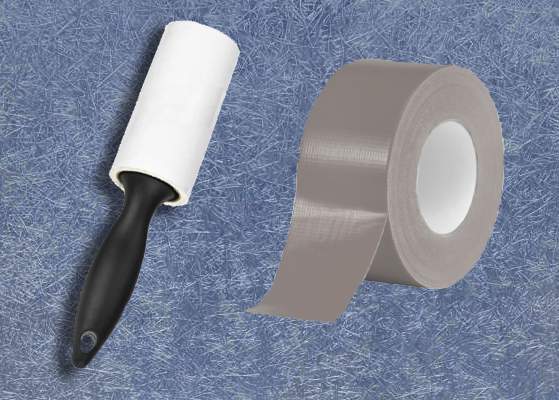How to Get Fiberglass Out of Your Skin
In order of effectiveness, based on real life experience from actual people, here are the current best practices.
Method 1: Lint Roller / Tape
Lightly roll a lint roller across the skin. The adhesive is not very strong, but it's convenient to use, and it allows you to roll an area multiple times.
Many people have had great success with lint rollers. It should take care of most of the problem, but there may be a few stragglers left behind. If you need a more potent solution, you can try something more sticky.
Apply tape lightly across the affected area. Don't rub it down too firmly. Only use moderate pressure, because you don't want to force the splinters in any further.
As you pull the tape away, most of the splinters should go with it.
You'll want to start with something light, like masking tape. If you'd like, you can move up to packing tape or duct tape. It just depends on how much you value your body hair.

Method 2: Cold Water
Another tried and true method is cold water. The cold temperature causes your skin to tighten. Shrinking up your pores can be a great way to prevent the glass from going any deeper. It may even force some of the splinters out, or at least closer to the surface.
Some people suggest warm water and soap. If cold water fails, it may be worth a shot.
Method 3: Old School
A classic trick for getting fiberglass off your skin is pantyhose. The tightly knit material can grab onto the fibers like Velcro. Bonus Tip: Don't even think about putting the pantyhose back in the drawer after this. They're done.
Method 4: Apple Cider Vinegar
This is a backup method. If you've tried the more effective techniques above, but you aren't getting relief, try rubbing on some apple cider vinegar. Does vinegar remove the fiberglass? No, not really. Apple cider vinegar is meant to dissolve the fiberglass. It works so well that many people reported getting relief within minutes of using it.
If you've got some apple cider vinegar around, that's great. If not, and you're really struggling with fiberglass itch, it's probably worth picking up a bottle. It's pretty widely available.

Vinegar contains acetic acid. This is what gives it that distinctive smell. It's not certain that apple cider vinegar is the only way to go here. You may be able to use standard white vinegar. Apple cider vinegar is slightly less acidic though, so it might be a little easier on your skin.
My personal choice is to use a good organic apple cider vinegar, because you can use the leftovers for an excellent homemade BBQ sauce. Here's the recipe:
1/2 Cup Ketchup
1/4 Cup Water
2 Tablespoons Brown Sugar
1 Tablespoon Honey
1/2 Tablespoon Apple Cider Vinegar
2 Teaspoons Chili Powder
1/2 Teaspoon Salt
1 Glug of Liquid Smoke
Method 5: Shaving Cream and a Credit Card
If you've come this far, things must not be going well.
Apply the shaving cream and then use the credit card as if you're shaving the area. The friction of the card across the skin may help pull out the fibers. The shaving cream helps them stick to the card.
How to Avoid Fiberglass in Your Skin
If you're reading this article, this information is coming a little too late. However, if it's not too late, here are some simple tips.
Wear a long sleeve shirt and gloves. This is obvious, but when you're working hard—especially in warm temperatures—your instinct is to shed layers. Avoid the urge, because doing so removes your most practical form of protection from fiberglass.
You also don't want to get fiberglass in your esophagus or lungs, so wear a painter's mask. If you have accidentally gotten some fiberglass in your throat, some people have found success with eating a piece of bread, which can grab onto the splinters on its way down. It seems to be more effective than simply drinking water.
Do I have fiberglass in my skin?
If you have fiberglass on your skin, you'll notice itching and maybe small, sharp stinging pains. Fiberglass acts like tiny splinters, and it's very effective at penetrating the skin. It can be more challenging to remove than wood splinters, because instead of one or two splinters, you may get one or two hundred of them at a time. They're also extremely difficult to see, since glass is clear. However, it's easily recognized by the red irritation it can cause on the skin.
Although the glass fibers are hard to see, they are not impossible to find. If you're wondering if you (or one of your children, maybe) have picked up some fiberglass, look at the area under good light. Under a bright light, or sunlight, you'll get a lot of reflection. You're looking for shiny little lines. This is really great for seeing how large of an area you need to treat. It's especially helpful when it's another person, like a kid, that you're helping, since you cannot feel what they're feeling.
The Many Sources of Fiberglass
Fiberglass isn't just found in insulation. You can find it in a number of places, because it's a light, yet firm material. You can pick up fiberglass splinters from:
- boats
- decks
- motorcycle headers
- water slides
- pools
- surf boards
- circuit boards
- car bumpers
Final Tips
If you know you've gotten fiberglass on your skin, don't wait around. As soon as you get a chance, try to take care of it. This probably isn't convenient when you're in the middle of an install, but the longer you wait, the more chance the fiberglass has of going deeper into your skin. Also, your skin will start reacting the the invader. This is when you get the redness and itchiness.
Although fiberglass can be difficult to see on your skin, you may be able to locate individual slivers. If that's the case, they can be carefully removed with tweezers or hemostats. Just be sure to clean off whatever instrument you choose for removal, otherwise you may cause yourself some issues the next time you use it.
When you feel pretty confident that you've removed the fiberglass splinters, make sure to wash the area with soap and water. This helps clear up infections that may have been introduced.
There may be residual itching. This can be caused by foreign bacteria on the fiberglass, or probably more likely, fiberglass that remains deeper in the skin. You can try anti-itch cream to calm your skins reaction to the slivers. You can also give the apple cider vinegar a shot, because it will be able to penetrate the skin better than tools like tweezers.
